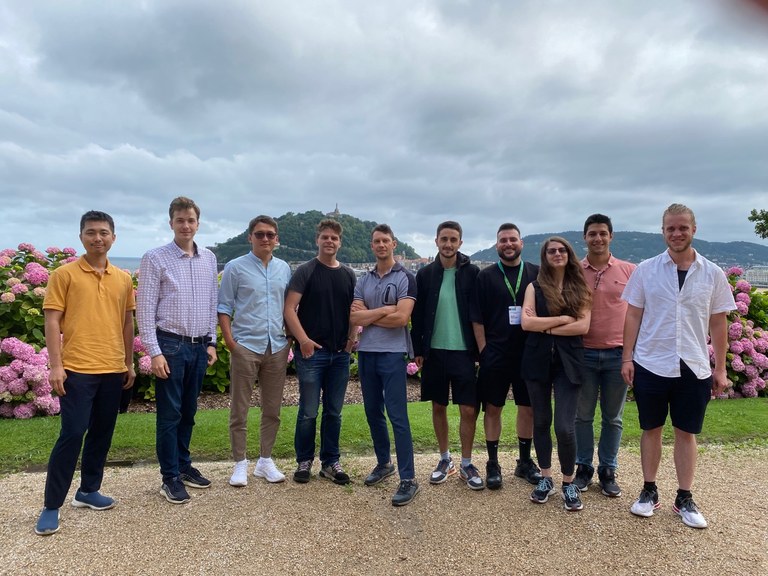Researchers demonstrate on-demand guiding of light at the nanoscale by twisting three atomically thin layers
An international team, led by the University of Oviedo and the CINN-CSIC, together with the Donostia International Physics Center, demonstrates the possibility of reconfiguring and channelling light at the nanoscale along any direction and on demand

The interplay between light and nanoscale structures, up to 100,000 times smaller than a human hair, defies conventional expectations. Exploring the realm of such dimensions has not only unraveled counter-intuitive optical phenomena but has also illuminated a host of thrilling possibilities for next-generation technologies. These include groundbreaking designs for integrated circuitry, optical computing, and bio-sensing. The impact of these innovations can extend to diverse fields, such as telecommunications, biomedical sciences, and renewable energy, paving the way for transformative progress. Now, an international team of researchers, led by the Quantum Nano-optics Group at the University of Oviedo and the Nanomaterials and Nanotechnology Research Centre (CINN-CSIC), together with the 2D Nanophotonics Group at the Donostia International Physics Center (DIPC), has taken a significant step forward. In a study published in the prestigious scientific journal Nature Materials, they have demonstrated the possibility of reconfiguring and channelling light at the nanoscale along any direction and on demand.
At the heart of this finding are what are known as two-dimensional (2D) materials, a family of exceptionally thin materials, just a few atoms thick, which are tremendously interesting as they exhibit unique properties compared to materials of much greater thickness. As a result of their thinness, these materials showcase distinctive properties that render them highly intriguing and valuable across various scientific and technological domains. Atomically thin materials possess very high strength, flexibility, and outstanding electrical and thermal conductivity, enabling the efficient conduction of both electricity and heat. Furthermore, combining these materials, much like interlocking Lego blocks, allows for a synergistic harnessing of their unique physical properties. This opens up remarkable opportunities to engineer novel functionalities and explore uncharted territories within the realms of nanoscience and device technology, in particular when it comes to controlling the propagation of light at the nanoscale (nanolight).
In 2020, four independent international research groups made groundbreaking discoveries regarding the manipulation of nanolight by combining different layers of such materials. These groups found that not only is it possible to control light by combining different layers, but the precise alignment and orientation of these layers also play a crucial role. The material that was used in their experiments is molybdenum trioxide (MoO3), a semiconductor widely employed in the fabrication of light-emitting diodes (LEDs). By stacking two extremely thin slabs of MoO3 and rotating one of them at a specific angle, known as the "magic angle", these researchers observed nanolight propagating along a specific direction, i.e. it became "canalized". “Intuitively, this can be seen as a natural cable or waveguide for nanolight”, explains Jiahua Duan, the main author of one of the four studies back in 2020. These groundbreaking experiments laid the foundation for a novel field of research referred to as "twistoptics". The primary objective of this field is to guide and manipulate canalized light at the nanoscale using twisted layers of atomically thin materials.
Now, an international team of researchers, led by the Quantum Nano-optics Group at University of Oviedo and the Nanomaterials and Nanotechnology Research Center (CINN-CSIC), together with the 2D Nanophotonics Group at the Donostia International Physics Center (DIPC) in Spain, has taken a significant step forward in the field of twistoptics. In a study published in the prestigious scientific journal Nature Materials, they have demonstrated the possibility to reconfigure and steer canalized light along any direction within such layered structures. In their experiments, the scientists stacked three layers of MoO3 and repeatedly adjusted the twist angles by disassembling and reassembling the resulting trilayers. By exciting light using a nanoscale gold rod as an optical emitter, they successfully controlled highly focused light according to their desired specifications, precisely varying the twist angles. The team made a fascinating discovery: while twisted bilayers possess only one specific angle that gives rise to canalization effects, twisted trilayers exhibit multiple magic angles for each layer. Using these three thin layers, nanolight can be guided and steered at will along any direction on the surface of the layers. What's even more intriguing is that these magic angles exist across a wide energy range, meaning that nanolight can be canalized at many different frequencies, which is key for the technological application of this optical phenomenon.
“The visualization of on-demand propagation of nanolight in a broadband spectral range using twisted trilayers was truly unexpected. Adding a third layer to these systems seems to have deeper implications than one might initially think.”, says Pablo Alonso-González, leader of the Quantum Nano-optics Group at University of Oviedo. “Multiple and robust photonic magic angles in twisted trilayers allow us to manipulate the flow of light at the nanoscale like never before”, adds Gonzalo Álvarez Pérez, predoctoral researcher at the same group and co-first author of the paper. “The ability to arbitrarily change the canalization direction without assembling a new structure, but only slightly rotating the top layer brings twistoptics to the next level”, states Kirill Voronin, predoctoral researcher at the 2D Nanophotonics Group at DIPC.
Therefore, this breakthrough has opened up new possibilities for manipulating and harnessing light in nanoscale devices and applications. “The robust broadband light canalization can be potentially used in the development of the next generation ultra-compact optical circuits, as well as in other applications such as biosensing, heat management and communication technologies”, says Christian Lanza, predoctoral researcher in the Quantum Nano-optics Group at University of Oviedo and co-first author of the work.
Reference
“Multiple and spectrally robust photonic magic angles in reconfigurable α-MoO3 trilayers” J. Duan, G. Álvarez-Pérez, C. Lanza, K. Voronin, A.I.F. Tresguerres- Mata, N. Capote-Robayna, J. Álvarez-Cuervo, A. Tarazaga Martín-Luengo, J. Martín-Sánchez, V.S. Volkov, A.Y. Nikitin, and P. Alonso-González. Nature Materials (2023). DOI: 10.1038/s41563-023-01582-5.
Institutions
- Department of Physics, University of Oviedo, Oviedo 33006, Spain.
- Center of Research on Nanomaterials and Nanotechnology, CINN (CSIC-Universidad de Oviedo), El Entrego 33940, Spain.
- Donostia International Physics Center (DIPC), Donostia-San Sebastián 20018, Spain
- Centre for Quantum Physics, Key Laboratory of Advanced Optoelectronic Quantum Architecture and Measurement (MOE), School of Physics, Beijing Institute of Technology, Beijing 100081, China.
- Beijing Key Laboratory of Nanophotonics & Ultrafine Optoelectronic Systems, Beijing Institute of Technology, Beijing 100081, China.

